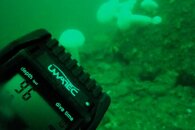Well yes and no, there is extreme current, here is a pic of the bottom, and this was awhile ago of close to the pic, I went for scallops, the cabezon was a bonus.
I just use a soft bottom zodiac with a 25 horse right now and only use land sights, When i hit bottom I missed my 180' target which is the second pic earlier this year where the scallops are abundant. after a minute of flying the bottom and only a half dozen scallops, seen a cabezon, planted my gun in bottom and looked to be busy collecting made my way closer with hand over knee to where I could get in range for a shot when I flew by. Slightly gave a view and the boy was still there, I lifted with knee, the current took me on my way, i looked to the right and had speargun pointed to the left with a slight glance I had it and shot, took off to the surface and pulled the fella close to me, grabbed the shaft and put him on my stringer on my safety stop.
Actually a bounce dive to this depth in a short amount of time is a skill that is only accomplished through experience.





